The Somnath Temple, located in Prabhas Patan near Veraval in Gujarat, India, is a masterpiece of architecture and a beacon of spiritual devotion. Known as one of the twelve Jyotirlinga shrines of Lord Shiva, the temple is revered for its rich history, intricate architecture, and profound spiritual significance. This ancient temple, standing resilient through the ages, continues to attract millions of pilgrims and tourists from around the world.
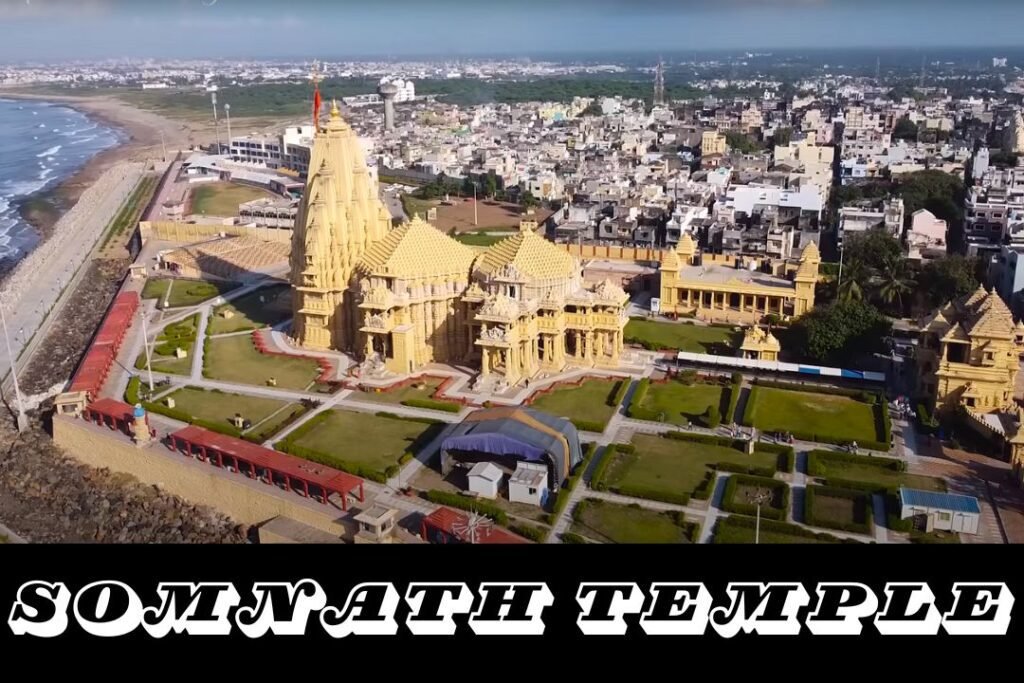
Table of Contents
Historical Significance
Ancient Origins: The Somnath Temple’s origins are shrouded in mythology. According to legends, the Moon God Soma built the first temple in gold to atone for a curse placed upon him by his father-in-law, Daksha. The temple was later rebuilt in silver by Ravana, in sandalwood by Krishna, and in stone by Bhimdev, highlighting its continual importance throughout different eras.
Destruction and Reconstruction: The temple has witnessed a turbulent history of destruction and reconstruction. Notable instances include:
- Mahmud Ghazni: In 1024 AD, Mahmud of Ghazni invaded the temple, looting its wealth and demolishing its structure. This marked the first of several destructions.
- Subsequent Attacks: Over the centuries, the temple faced multiple attacks by various rulers, including Alauddin Khilji and Aurangzeb, each time being restored by the devout.
- Modern Reconstruction: In 1951, under the leadership of Sardar Vallabhbhai Patel and with contributions from numerous devotees, the temple was rebuilt in its current form, symbolizing India’s post-independence resilience and cultural pride.
Modern Era: The present structure is an embodiment of both ancient tradition and modern architectural prowess. The temple stands as a symbol of faith and resilience, reflecting the undying spirit of its devotees.
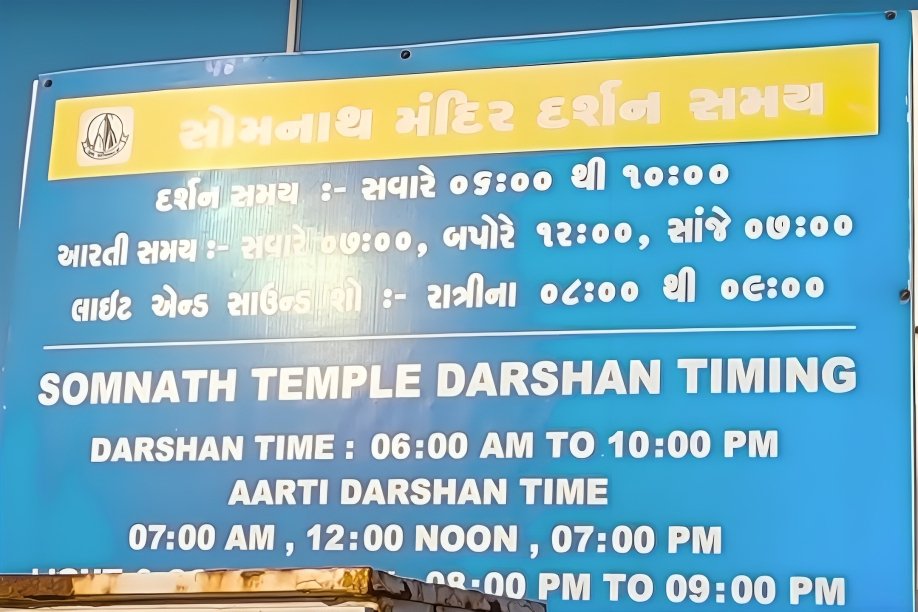

Architectural Marvel
Chalukya Style: The Somnath Temple is a quintessential example of Chalukya architecture, characterized by its intricate carvings, grandeur, and symmetry. The temple’s shikhara (spire) rises to a height of about 50 meters, crowned with a kalash (pot) weighing 10 tons.
Intricate Carvings: The temple walls are adorned with intricate carvings depicting scenes from Hindu mythology, floral motifs, and geometrical patterns. These carvings not only enhance the temple’s beauty but also narrate various stories from the scriptures.
Sculptures and Inscriptions:
- Nandi Statue: A large Nandi statue, the bull mount of Shiva, is prominently placed in the temple complex.
- Jyotirlinga: The main sanctum houses the revered Jyotirlinga, a symbolic representation of Lord Shiva, which is the focal point of worship.
- Historical Inscriptions: Various inscriptions within the temple premises document its historical timeline and the contributions of different rulers and devotees.
Somnath Stambha (Ban-Stambha): The Baan-Stambha or Arrow Pillar, situated on the sea defense wall of the temple, symbolizes its geographical importance, indicating that no land area comes between the pillar and the South Pole. This text was written in sanscrit many years ago when there was no technology.

Spiritual and Cultural Importance
Jyotirlinga: As one of the twelve Jyotirlingas, Somnath holds immense spiritual significance. Devotees believe that worshipping at these shrines bestows spiritual liberation and the blessings of Lord Shiva.
Festivals and Rituals: The temple is a hub of religious activities, especially during major Hindu festivals:
- Maha Shivaratri: This festival is celebrated with great fervor, attracting thousands of devotees who participate in night-long vigils and special rituals.
- Kartik Purnima: Another significant festival, marking the day Lord Shiva vanquished the demon Tripurasura.
Daily Aartis and Pujas: The temple conducts three main aartis – Morning, Noon, and Evening. These rituals, performed with devotion and grandeur, are major attractions for visitors seeking spiritual solace.
Light and Sound Show: The evening light and sound show at Somnath Temple narrates the temple’s history, making it an informative and entertaining experience for visitors.
Major Attractions in Somnath
Somnath Temple
The primary attraction, the Somnath Temple, offers a spiritual retreat with its daily rituals, aartis, and the light and sound show depicting its history.
Old Somnath Temple
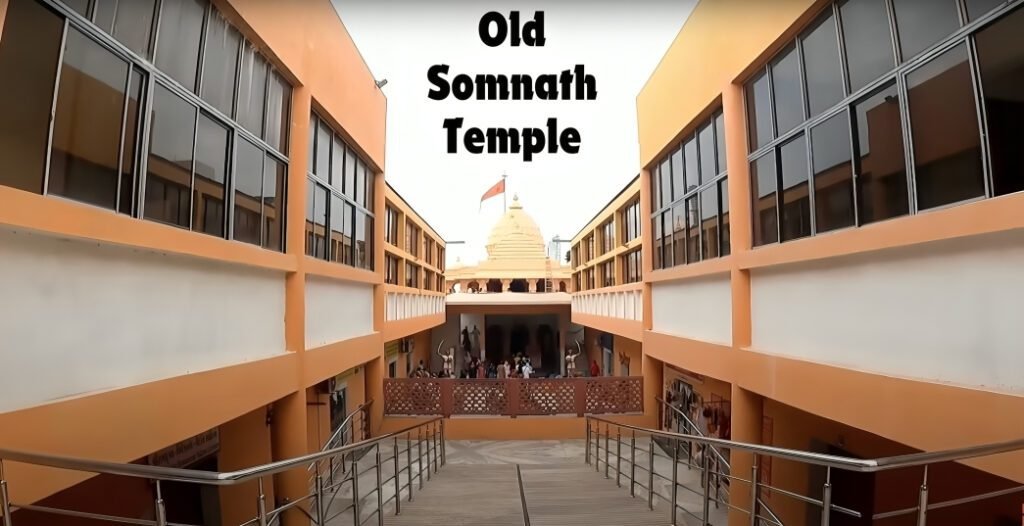
Historical Landmark: The Somnath Old Temple, also known as the Ahilyabai Temple, was reconstructed by the Maratha queen Ahilyabai Holkar in the 18th century. It stands as a testament to her devotion and efforts to preserve Hindu religious sites.
Spiritual Significance: The old temple holds significant religious value as it represents the original location where the Jyotirlinga was worshipped before the main temple was built.
Architectural Simplicity: Unlike the grand main temple, the old temple has a simpler design but carries a deep spiritual essence and historical charm.
Pilgrimage Importance: Many devotees visit the old temple to pay homage and experience the ancient roots of the Somnath pilgrimage tradition.
Somnath Beach
Scenic Spot: Somnath Beach is a beautiful stretch of coastline offering stunning views of the Arabian Sea, making it an ideal place for relaxation and enjoying the natural beauty.
Proximity to Somnath Temple: Located close to the Somnath Temple, the beach provides a serene environment for pilgrims to unwind after their temple visit.

Sunrise and Sunset Views: The beach is famous for its breathtaking sunrise and sunset views, making it a popular spot for photography enthusiasts.
Leisure Activities: Visitors can enjoy various activities such as camel rides, beach walks, and sampling local snacks from vendors, enhancing their beach experience.
Ban Ganga
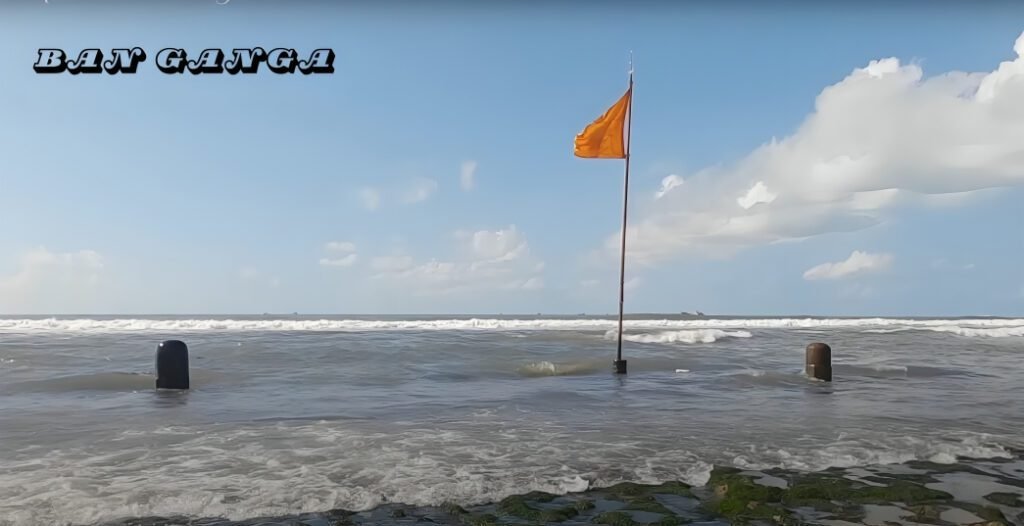
Mythological Origin: According to legend, Ban Ganga was created when Arjuna, one of the Pandava brothers from the Mahabharata, shot an arrow into the ground, bringing forth a spring of water.
Holy Waters: The waters of Ban Ganga are considered sacred by devotees. Pilgrims often take a dip in the spring, believing it will purify their sins and bring them good fortune.
Peaceful Environment: The area around Ban Ganga is serene and picturesque, making it an ideal spot for meditation and reflection.
Cultural Significance: The spring is an important site for local religious practices and festivals, often visited by devotees performing rituals and ceremonies.
Bhidbhanjan Temple
Dedicated to Lord Shiva: Bhidbhanjan Temple is dedicated to Lord Shiva, known as the remover of obstacles and troubles in the lives of his devotees.
Architectural Beauty: The temple is noted for its beautiful architecture, featuring intricate carvings and sculptures that reflect the artistic heritage of the region.

Spiritual Activities: Regular rituals, aartis, and special pujas are conducted here, attracting a large number of devotees seeking blessings and solutions to their problems.
Cultural Importance: The temple plays a significant role in the local community’s cultural and religious activities, serving as a hub for spiritual gatherings and festivals.
Bhalka Tirth

Legend of Lord Krishna: Bhalka Tirth is believed to be the place where Lord Krishna was mistakenly shot in the foot by a hunter named Jara, leading to his departure from the earthly realm. This event marks a significant moment in Hindu mythology.
Krishna’s Final Moments: The temple at Bhalka Tirth features a statue of Lord Krishna in a reclining position, depicting his last moments. It serves as a site of deep reverence for Krishna devotees.
Pilgrimage Site: Bhalka Tirth is an important pilgrimage destination, attracting devotees who come to pay their respects and meditate on Krishna’s divine presence.
Temple Complex: The site includes a small shrine and a memorial pillar, providing a peaceful environment for reflection and prayer.
Triveni Sangam
Confluence of Three Rivers: Triveni Sangam is the sacred confluence of the Hiran, Kapila, and Saraswati rivers, considered a holy spot for performing rituals and ceremonies.
Spiritual Significance: Bathing at the Triveni Sangam is believed to purify the soul and wash away sins, making it a popular site for pilgrims.
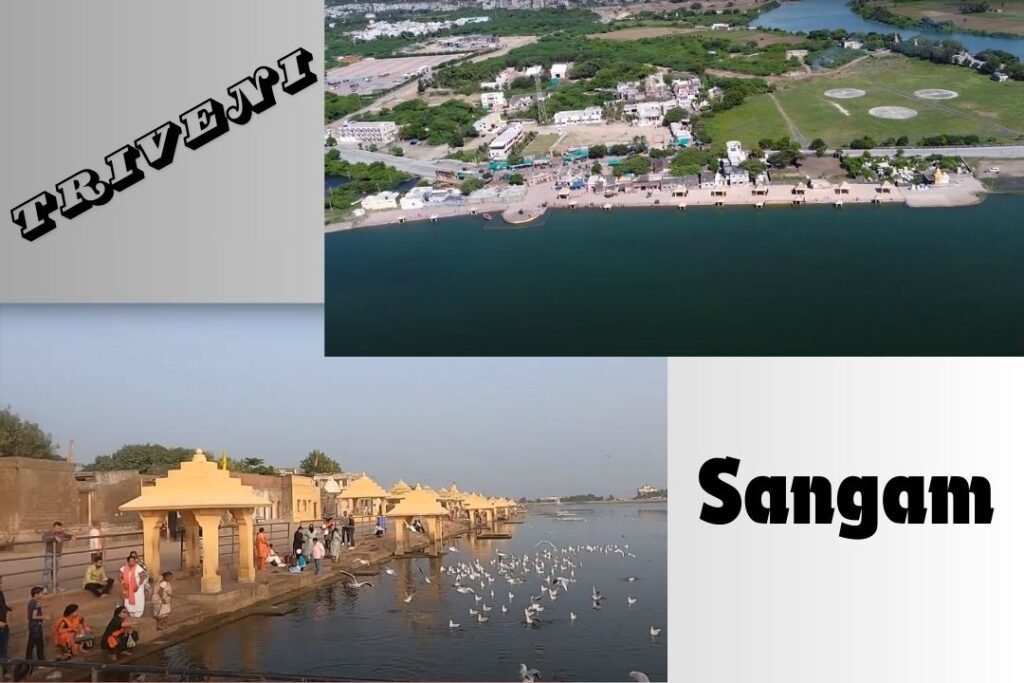
Rituals and Ceremonies: The site is often bustling with activities, including Pind Daan (ancestral offerings) and various other Hindu rituals.
Scenic and Serene: The confluence offers a serene and scenic environment, perfect for meditation and spiritual reflection.
Surya Mandir
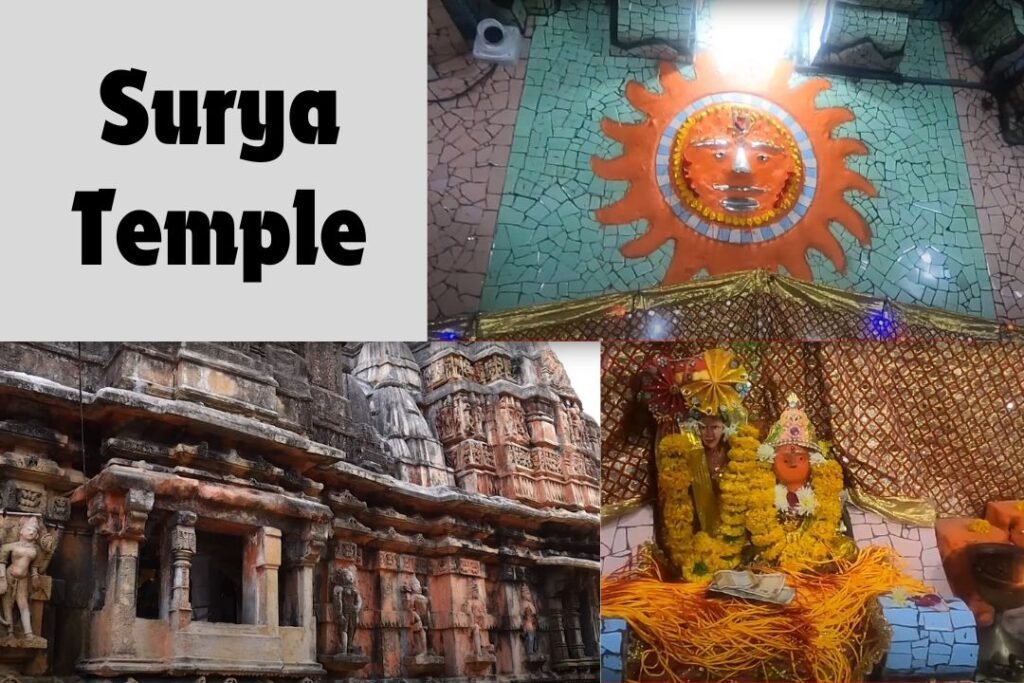
Dedicated to the Sun God: The Surya Mandir, or Sun Temple, is dedicated to Surya, the Sun God, highlighting the ancient Vedic tradition of sun worship.
Architectural Features: The temple showcases beautiful carvings and sculptures depicting the Sun God and various mythological scenes, reflecting the artistic excellence of the period.
Historical Relevance: The temple stands as a testament to the historical significance of sun worship in Gujarat and Indian culture.
Spiritual Practices: Devotees visit the temple to offer prayers during sunrise, seeking blessings for health, prosperity, and well-being.
Veneshvar Mahadev Temple
Dedicated to Lord Shiva: Veneshvar Mahadev Temple is another prominent temple dedicated to Lord Shiva, attracting devotees seeking blessings and spiritual solace.
Historical and Cultural Importance: The temple is an important part of the local religious landscape, with a history that adds to its cultural significance.
Architectural Design: The temple’s architecture, though simpler compared to the main Somnath Temple, features intricate carvings and a tranquil ambiance.
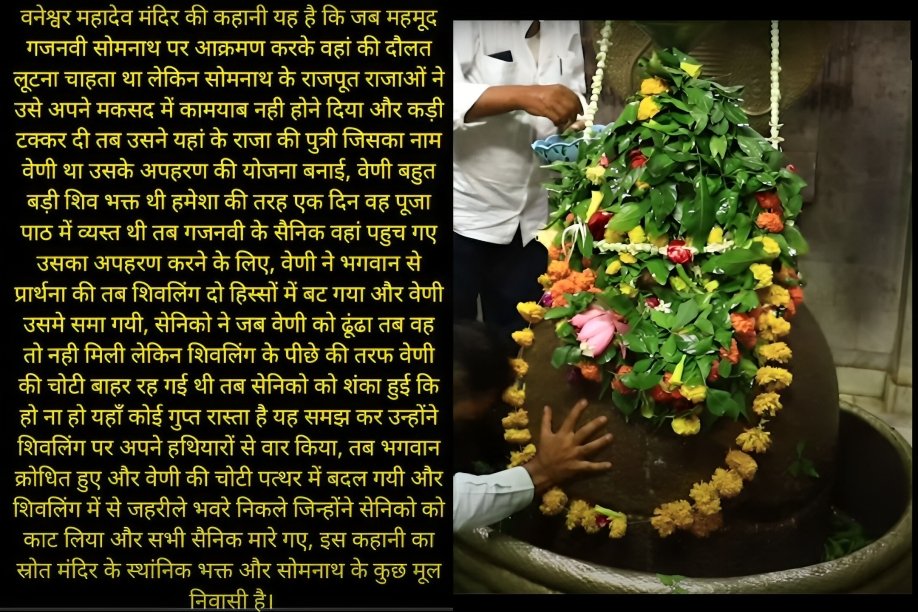
GolokDham Tirth
Golokdham Tirtha includes the following places:
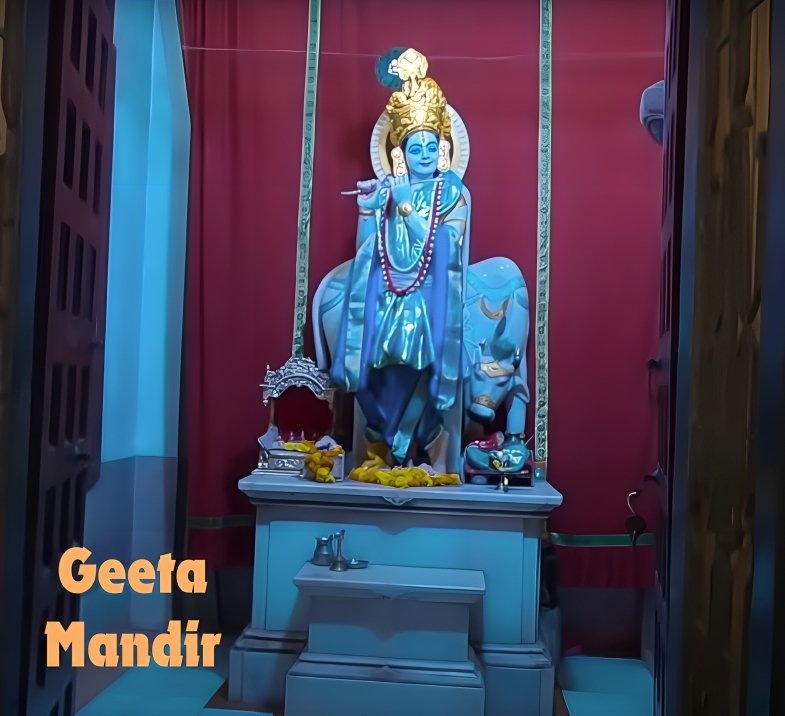
Geeta Mandir: Geeta Mandir is a significant place of worship and learning, dedicated to the teachings of the Bhagavad Gita. It serves as a hub for spiritual discourses, where devotees gather to study and contemplate the profound wisdom imparted by Lord Krishna to Arjuna on the battlefield of Kurukshetra.
Shree Lakshminarayan Mandir: Shree Lakshminarayan Mandir is a temple dedicated to Lord Vishnu, the preserver in the Hindu trinity. Devotees visit this sacred site to seek the blessings of Lord Vishnu and his consort, Goddess Lakshmi, for prosperity, happiness, and spiritual fulfillment.
Krishna Charan Paduka: Krishna Charan Paduka refers to the sacred footprints of Lord Krishna, believed to have been imprinted during his divine presence on Earth. Devotees venerate these footprints as symbols of Krishna’s eternal presence and seek his blessings for guidance and protection.
Golok Ghat: Golok Ghat is a revered ghat (river bank) situated along the holy river, where devotees gather for ritualistic bathing and spiritual activities. It provides a serene setting for prayers, meditation, and contemplation, allowing devotees to immerse themselves in the divine ambiance of the sacred waters.
Kashi Vishvanath Mandir: Kashi Vishvanath Mandir is dedicated to Lord Shiva, the destroyer in the Hindu trinity. It is one of the most revered temples in GolokDham Tirth, attracting devotees from far and wide who come to offer prayers and seek blessings from Lord Shiva for health, prosperity, and spiritual liberation.
Mahaprabhuji Bethak: Mahaprabhuji Bethak is a sacred site associated with the divine saint Shri Mahaprabhuji, the founder of the Pushtimarg tradition. It is believed to be the place where Mahaprabhuji resided and imparted spiritual teachings to his disciples. Devotees visit this bethak to seek inspiration and guidance on their spiritual journey.
Bhimnath Mandir: Bhimnath Mandir is a temple dedicated to Lord Shiva, revered as the supreme deity among Shaivite devotees. The temple is named after Bhima, one of the Pandava brothers from the Mahabharata, who is believed to have worshipped Lord Shiva at this sacred site. Devotees flock to Bhimnath Mandir to offer prayers and seek blessings from Lord Shiva for strength, courage, and liberation from worldly desires.
Nearby Attractions
Diu
Just around 80 km from Somnath, Diu is a picturesque island known for its stunning beaches, historic forts, and Portuguese architecture.
Visit Diu Fort, Naida Caves, Nagoa Beach, and Gangeshwar Mahadev Temple for a memorable experience.
Gir National Park
Approximately 70 km from Somnath, Gir National Park is home to the Asiatic lion, making it a popular wildlife destination.
Embark on a safari to spot lions, leopards, deer, and various bird species in their natural habitat.
Porbandar
Located about 125 km from Somnath, Porbandar is the birthplace of Mahatma Gandhi and offers insights into his life and legacy.
Explore Kirti Mandir, Gandhiji’s birthplace, and Sudama Mandir, dedicated to the childhood friend of Lord Krishna.
Dwarka
Around 230 km from Somnath, Dwarka is one of the Char Dham pilgrimage sites and holds immense religious significance for Hindus.
Visit Dwarkadhish Temple, Rukmini Devi Temple, Nageshwar Jyotirlinga Temple, and Dwarka Beach for a spiritual and cultural experience.
Veraval
Just 7 km from Somnath, Veraval is a coastal town known for its fishing industry and scenic beaches.
Visit Veraval Beach, Somnath Fisheries, and Prabhas Patan Museum for a relaxed seaside experience.
Chorwad Beach
Located around 25 km from Somnath, Chorwad Beach offers pristine shores and tranquil surroundings, ideal for a peaceful retreat.
Enjoy swimming, sunbathing, and beach picnics amidst stunning coastal scenery.
Prabhas Patan
A historical town near Somnath, Prabhas Patan is famous for its association with the Mahabharata and the Somnath Temple.
Explore the ancient ruins, Somnath Museum, and nearby temples for a glimpse into the region’s rich cultural heritage.
Girnar Hill:
Located around 95 km from Somnath, Girnar Hill is a sacred pilgrimage site and offers breathtaking views of the surrounding landscape.
Trek to the top of Girnar Hill to visit Jain temples, Hindu shrines, and enjoy panoramic vistas of the region.
How to Reach
By Air:
The nearest airport to Somnath is the Diu Airport (IATA: DIU), located approximately 85 km away. From Diu Airport, you can hire a taxi or take a bus to reach Somnath. Another option is to fly to Rajkot Airport (IATA: RAJ), which is about 195 km from Somnath, and then proceed by road.
By Train:
The nearest railway station to Somnath is Veraval Railway Station (VRL), which is well-connected to major cities like Ahmedabad, Mumbai, Delhi, and Rajkot. From Veraval Railway Station, you can hire a taxi or take a bus to reach Somnath, which is just 7 km away.
By Road:
Somnath is well-connected to various cities in Gujarat and neighboring states by road. You can reach Somnath by state-run buses, private buses, or hired taxis from cities like Ahmedabad, Rajkot, Junagadh, Dwarka, and Porbandar. The roads leading to Somnath are well-maintained, offering a comfortable journey for travelers.
If you prefer a self-driven journey, you can reach Somnath by car via the national highways and state highways that connect it to major cities in Gujarat and neighboring states.
Local Transportation:
Once you reach Somnath, getting around the city is easy with various local transportation options. Auto-rickshaws, cycle-rickshaws, and taxis are readily available for short-distance travel within the city. You can also explore nearby attractions and temples on foot or by hiring a bicycle or motorcycle from local rental services.
Accommodations
- Somnath Trust Guest House: Managed by the Somnath Temple Trust, offering budget-friendly accommodation with basic amenities for pilgrims and travelers.
- Hotel Shubh Suvidha: A mid-range hotel located near the Somnath Temple, offering comfortable rooms and modern facilities for tourists.
- Hotel Ambar: A budget hotel situated close to the temple, providing clean and affordable rooms for pilgrims and travelers on a tight budget.
- The Fern Residency Somnath: A luxury hotel offering premium accommodation and amenities for travelers seeking a luxurious stay experience.
- Safari Resort: Located near Somnath Beach, this resort offers a tranquil ambiance and comfortable cottages for a relaxing getaway.
- Hotel Somnath Atithigruh: A popular choice among budget travelers, offering clean rooms and warm hospitality near the temple.
- Hotel Shyam: Another budget hotel option near the Somnath Temple, providing basic amenities and convenience for pilgrims and tourists.
- Hotel Heritage: Situated in the heart of Somnath, this hotel offers a blend of modern comforts and traditional hospitality for a memorable stay experience.
Local Cuisine
- Dhokla: A staple Gujarati snack made from fermented chickpea flour, dhokla is steamed to perfection and typically served with green chutney or sweet tamarind chutney.
- Fafda: Crisp and savory, fafda is a popular Gujarati snack made from gram flour (besan) and spices. It is often served with spicy green chutney and fried green chilies.
- Khandvi: Delicate and flavorful, khandvi is a savory snack made from gram flour and yogurt. It is rolled into thin, bite-sized pieces and garnished with mustard seeds, curry leaves, and grated coconut.
- Thepla: A soft and flavorful flatbread made from whole wheat flour, fenugreek leaves (methi), and spices, thepla is perfect for breakfast or as a snack. It pairs well with yogurt or pickle.
- Undhiyu: A traditional Gujarati mixed vegetable curry, undhiyu is made from a medley of seasonal vegetables, fenugreek dumplings (muthia), and a blend of spices. It is usually eaten with puri or roti.
- Gujarati Thali: A wholesome meal consisting of a variety of dishes, including dal (lentil curry), kadhi (yogurt-based curry), vegetable curries, rice, roti, papad, pickles, and sweets like shrikhand or jalebi.
- Handvo: A savory cake made from a batter of rice, lentils, and vegetables, handvo is seasoned with spices and cooked until golden brown. It is tried as a snack or a light meal.
Travel tips and Safety advice
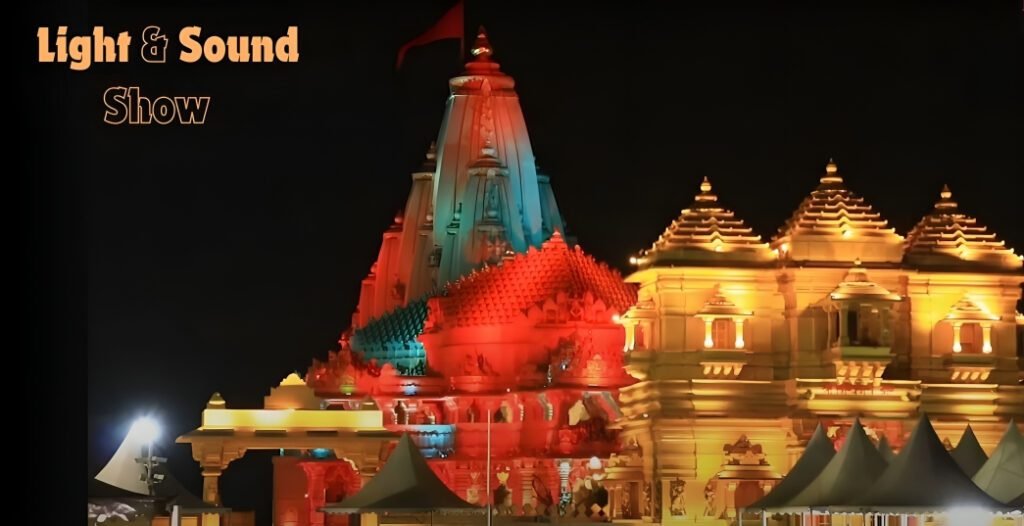
Plan Ahead: Research about Somnath, including its major attractions, local customs, and transportation options, before your visit to make the most of your trip.
Best Time to Visit: The ideal time to visit Somnath is from October to March when the weather is pleasant and suitable for sightseeing and outdoor activities.
Temple Etiquette: When visiting the Somnath Temple, dress modestly and remove your footwear before entering the temple premises as a sign of respect.
Accommodation Booking: Book your accommodation in advance, especially during peak tourist seasons, to ensure availability and get the best deals.
Local Cuisine: Don’t miss out on trying the delicious local cuisine of Somnath, including dhokla, fafda, and Gujarati thali, at local eateries and restaurants.
Stay Hydrated: Carry a water bottle with you and stay hydrated, especially during the hot summer months, to prevent dehydration and fatigue.
Bargaining: If shopping at local markets, feel free to bargain for better prices, but do so politely and respectfully.
Currency: Carry sufficient cash in Indian rupees, as many small vendors and shops may not accept credit/debit cards.
Language: Learn a few basic phrases in Gujarati or Hindi to communicate with locals, although many people in Somnath also understand English.
Stay Vigilant: Keep an eye on your belongings and valuables, especially in crowded areas like markets and tourist attractions, to avoid theft or pickpocketing.
Health Precautions: Drink bottled or boiled water to avoid water-borne illnesses, and carry essential medications and a first-aid kit for minor health issues.
Sun Protection: Wear sunscreen, sunglasses, and a hat to protect yourself from the harsh sun, especially during outdoor activities and temple visits.
Cultural Sensitivity: Respect local customs and traditions, and refrain from engaging in behavior that may be considered disrespectful or offensive to the local community.
Travel Documentation: Keep copies of your passport, visa, and other important travel documents in a separate place from the originals, and carry them with you at all times.
Conclusion
The Somnath Temple stands as a beacon of spirituality, architectural grandeur, and historical resilience. Whether you are a devout pilgrim, a history enthusiast, or an architecture lover, Somnath offers a rich and profound experience. A visit to this sacred site not only provides a glimpse into India’s illustrious past but also offers a serene escape for the soul.
Embark on this spiritual journey and let the divine aura of Somnath Temple leave an indelible mark on your heart.

Frequently Asked Questions (FAQs)
What is Somnath famous for?
Somnath is renowned for its ancient Somnath Temple, one of the twelve Jyotirlingas dedicated to Lord Shiva, and its rich historical and cultural significance.
How far is Somnath Temple from the nearest airport?
The nearest airport to Somnath is Diu Airport, located approximately 85 km away, which is about a 2-hour drive by road.
What are the timings of the Somnath Temple?
The Somnath Temple is open for darshan (worship) from early morning to late evening. The timings may vary, so it’s advisable to check the temple’s official website or inquire locally for the current schedule.
Is there an entry fee to enter Somnath Temple?
No, there is no entry fee to visit the Somnath Temple. However, donations are welcome and voluntary.
What are the major festivals celebrated in Somnath?
Some of the major festivals celebrated in Somnath include Maha Shivaratri, Kartik Purnima, Navratri, and Diwali. These festivals attract large crowds of devotees to the temple.
Are there any accommodation facilities near Somnath Temple?
Yes, there are various accommodation options available near the Somnath Temple, including guest houses, hotels, and resorts, catering to different budgets and preferences.
What are the nearby attractions to visit in Somnath?
Some nearby attractions to visit in Somnath include Bhalka Tirth, Triveni Sangam, Somnath Beach, and the Somnath Old Temple, among others.
Is it safe to travel to Somnath?
Yes, Somnath is generally considered safe for travelers. However, it’s advisable to take usual precautions regarding personal safety and belongings, especially in crowded areas.
Can I take photographs inside the Somnath Temple?
Photography inside the Somnath Temple is restricted in certain areas. It’s best to inquire locally or check with temple authorities for specific guidelines regarding photography.
What is the significance of the Somnath Jyotirlinga?
The Somnath Jyotirlinga is believed to be one of the holiest shrines dedicated to Lord Shiva and holds immense spiritual significance for devotees. It is believed to fulfill wishes and bestow blessings upon devotees.
Are there any guided tours available for exploring Somnath?
Yes, guided tours are available for exploring Somnath and its surrounding attractions. You can inquire with local tour operators or travel agencies for guided tour packages.
Is there a dress code to enter the Somnath Temple?
While there is no strict dress code, visitors are advised to dress modestly and respectfully when visiting the Somnath Temple, covering their shoulders and legs.
What are the timings of the light and sound show at Somnath Temple?
The light and sound show at Somnath Temple is typically held in the evening, showcasing the temple’s history and legends. The timings may vary depending on the season, so it’s recommended to check locally for the current schedule.
Can I witness the Aarti rituals at the Somnath Temple?
Yes, the Somnath Temple conducts several Aarti rituals throughout the day, including morning, noon, and evening Aartis. Visitors are welcome to witness these sacred rituals and participate in the divine atmosphere of the temple.


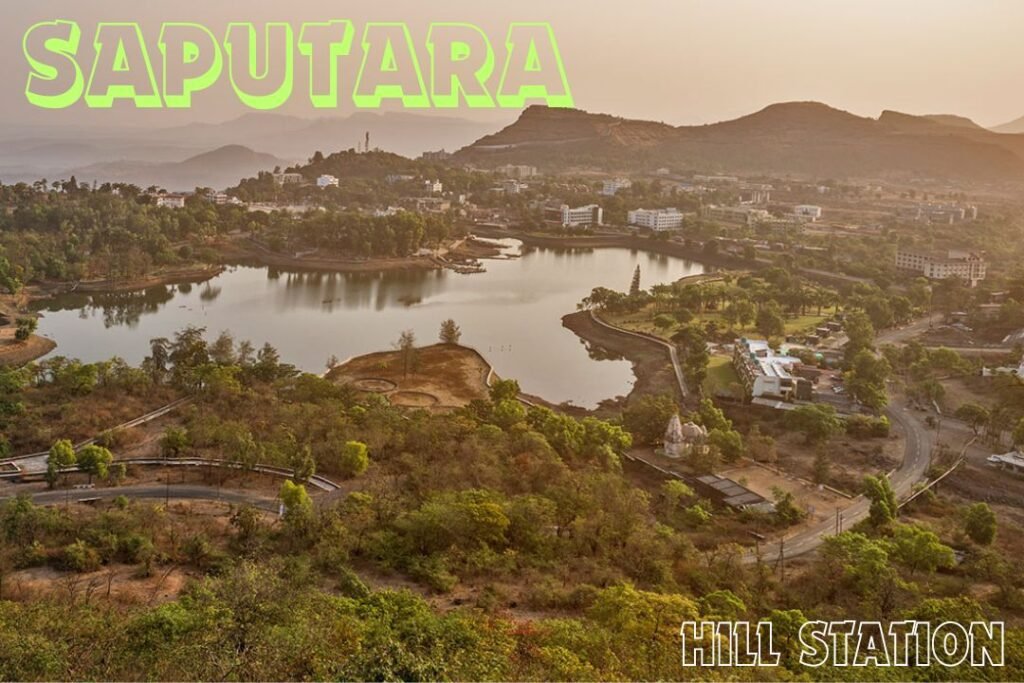
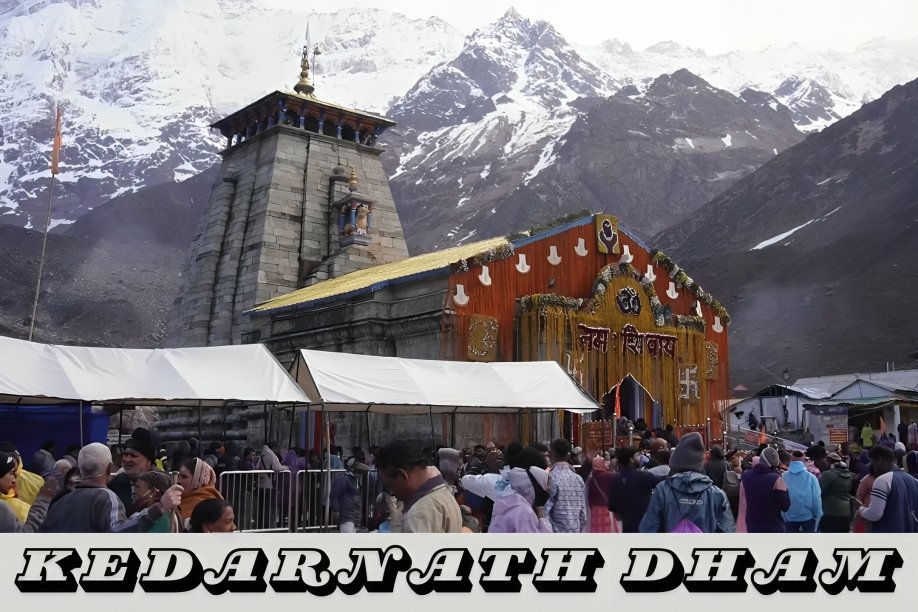
Pingback: Mahakaleshwar Temple: A Sanctuary of Divine Energy - GujjuTraveling
Pingback: Mallikarjuna Jyotirlinga: A Journey into Sacred Wonders - GujjuTraveling
Pingback: Dwarka: Discovering the Top 10 Unforgettable Attractions You Can’t Miss - GujjuTraveling
Pingback: Kedarnath Temple: Considered the supreme abode of Lord Shiva 1 - GujjuTraveling